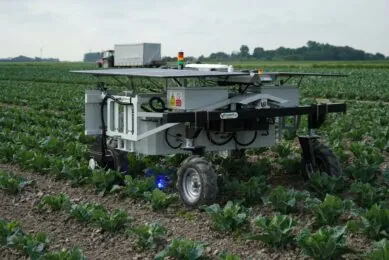Australian harvesting robot picks apples in seven seconds

An Australian research team of Monash University has developed an autonomous harvesting robot capable of identifying, picking and depositing apples in as little as seven seconds at full capacity.
Team leader Dr Chao Chen of Monash University’s Department of Mechanical and Aerospace Engineering expects the researchers will be further developing the robot in the next three years. “We need to keep this project going. If we can continue with sufficient resources, we will develop a full commercially operable prototype. We can then allow farmers to use it and see it.”
Harvest apples autonomously
Eventually the fruit picking robot will be able to harvest autonomously and work 24 hours a day in all weather conditions. Growers will be able to lease the robot or purchase it outright.
Following extensive trials at Fankhauser Apples in Drouin, Victoria, the robot was able to harvest more than 85 per cent of all reachable apples in the canopy as identified by its vision system. Of all apples harvested, less than 6 per cent were damaged due to stem removal. Apples without stems can still be sold, but don’t necessarily fit the cosmetic guidelines of some retailers.
Identify and categorise obstacles
Dr Chen, who is also Director of Laboratory of Motion Generation and Analysis, says that the developed vision system can not only positively identify apples in a tree within its range in an outdoors orchard environment by means of deep learning, but can also identify and categorise obstacles, such as leaves and branches, to calculate the optimum trajectory for apple extraction.
There are a number of things we want to improve
Dr Chen emphasises the robot is still under development. “The harvesting season is almost finished. We are still doing some tests and are collecting additional data. There are a number of things we want to improve.”
Increasing the success rate of the picking process
The team will be working on the workspace of the robot, so that it can cover the entire tree. It will also further increase the success rate of the picking process, and enable the robot to better deal with complications and fruit in the orchard.
“With improved intelligence of the robot, we could go around the branches and reach the inside of the canopy”, Dr Chen explains. ”And if we improve the intensity of sensing, we could detect the fruit behind branches and leaves accurately. But we also want to improve the autonomy of the robot, so it can travel along the isles of the orchard and harvest completely autonomously.”
Maximising the number of apples that can be harvested

Automatic harvesting robots, while a promising technology for the agricultural industry, pose challenges for fruit and vegetable growers. Robotic harvesting of fruit and vegetables requires the vision system to detect and localise the produce. To increase the success rate and reduce the damage of produce during the harvesting process, information on the shape, and stem-branch joint location and orientation are also required.
To counter this problem, the researchers created a motion-planning algorithm featuring fast-generation of collision-free trajectories to minimise processing and travel times between apples, reducing harvesting time and maximising the number of apples that can be harvested at a single location.
The robot’s vision system can currently identify more than 90 per cent of all visible apples seen within the camera’s view from a distance of approximately 1.2m. The system can work in all types of lighting and weather conditions, including intense sunlight and rain, and takes less than 200 milliseconds to process the image of an apple.
“We also implemented a path-planning algorithm that is able to generate collision-free trajectories for more than 95 per cent of all reachable apples in the canopy”, Dr Chen says.
Solving the current labour shortage
The robot grasps apples with a specially designed, pneumatically powered, soft gripper with four independently actuated fingers and suction system that grasps and extracts apples efficiently, while minimising damage to the fruit and the tree itself.
In addition, the suction system draws the apple from the canopy into the gripper, reducing the need for the gripper to reach into the canopy and potentially damaging its surroundings. The gripper can extract more than 85 per cent of all apples from the canopy that were planned for harvesting.
According to Dr Chen, the system can address the challenges of solving the current labour shortage in Australia’s agricultural sector. “And it can address the future food crisis as the population grows and there is decreased arable land. Technological advances could also help increase the productivity of fruit and attract younger people to working in farms with this technology.”
Join 17,000+ subscribers
Subscribe to our newsletter to stay updated about all the need-to-know content in the agricultural sector, two times a week.



